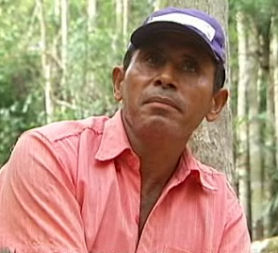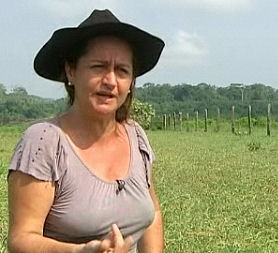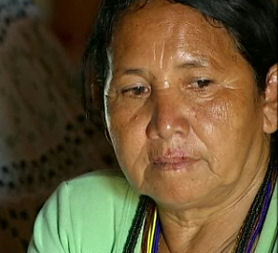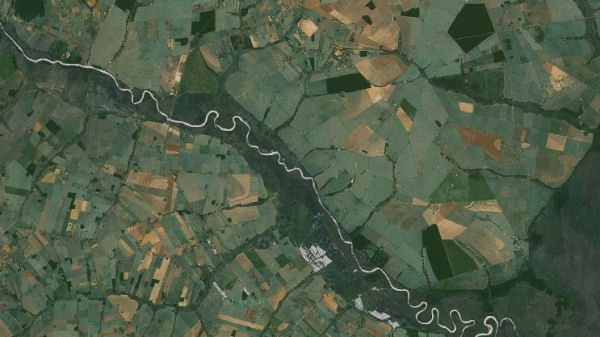Amazon rainforest: can we save the planet’s lungs?
Should rich countries pay to save the world’s rainforests? Foreign Correspondent Jonathan Miller travelled through the Amazon to find out if a strategy called the Redd plan can really work.
Deforestation accounts for one fifth of global greenhouse gas emissions and halting it would be as powerful as closing all the world’s coal-fired power plants.
Details of the Redd (Reducing Emissions from Deforestation and forest Degradation) plan are complex but at root it involves rich countries paying countries with rainforests not to cut down trees.
Jonathan Miller travelled for 2,000 miles across the Amazon Basin, which contains more than half the world’s remaining rainforest.
Jonathan Miller travelled for 2,000 miles across the Amazon Basin, which contains more than half the world’s remaining rainforest, to ask Brazilians who live and work there what they make of this plan.
He visited Amazonas where he met illegal loggers, goldminers and ranchers, then to Mato Grosso to visit native Indians of the Parecis tribe and on to Rondonia where he joined the Amazon’s airbourne enforcement police, to see for himself the extent of the destruction and the challenges of making Redd work.
Could they be enticed to treat this forest as the global resource we like to think it is? And who among the Amazon’s 30 million people stands to gain
Redd or dead?
It is well known that trees absorb carbon dioxide. But when they are destroyed they also release C02 into the air - a double environmental hazard.
Forest loss contributes annually to 12-15 per cent of global greenhouse gas emissions.
Redd stands for "reducing emissions from deforestation and degradation".
Currently forests are worth more felled than standing. Redd aims to reverse this and make living trees more valuable - financially and environmentally.
The Redd fund could be worth 1.5bn pounds a year to Brazil.

On the first leg of the trip, Channel 4 News found illegal chainsaw gangs chopping down trees. These men know the world now brands them environmental terrorists, but they are not put off.
One of them, Flavio Maginata, explained: “We don’t want to get paid to do nothing; we want to live here, working at what we do.
“Why is it that rich countries are so interested in preserving the Amazon and they don’t preserve their own forest? Tell me that.
“This is Brazil, I’m a Brazilian and this is what I do.”
“I’m a Brazilian and this is what I do.” Flavio Maginata
The team then travelled along a stretch of a 500 mile road which cuts through the heart of the Amazon.
When you put down tarmac it makes it even easier for people and big logging trucks to pillage the jungle.
They build little roads off big roads and satellite imagery shows that in the Amazon alone, there are now 173,000km of clandestine, illegal roads. That is enough to encircle the earth four times over.
Amazonian Chainsaw Massacre
The chainsaws are real. All of them, confiscated by police officers from illegal loggers. Weapons, put beyond use, as they say.
Turning the tools of the illegal timber trade into sculptures is the ecowarriors' equivalent, I suppose, of turning swords into ploughshares.
These environmental enforcers have been tasked with a mission by the Brazilian government on behalf of the planet: to end the chainsaw massacre of the Amazon.
Read more from Jonathan Miller's blog

Goldminer Flavio Nego insisted he destroys less forest than a rancher.
He said: “In one year, a rancher can destroy millions and millions of hectares but we stay in the same place for years. We destroy a fraction of what they destroy.”
Brazil’s meat industry is the biggest in the world and cattle farmers are responsible for the vast majority of the deforestation. Early on, ranchers grabbed land up here too, and like the illegal loggers and miners, felled great swathes of rainforest.
Augair Vuicik bought her 2,500 hectare ranch legally 25 years ago. More than half of its still forested. If it is to stay that way, she cannot expand her herd and for that she believes should be compensated.
She told Channel 4 News: “It is not our fault what is happening to the world.
“They have to give us a financial incentive to stop cutting down the trees because people cannot just stop working because the world thinks that saving the Amazon is going to save the planet.
“They have to give us a financial incentive to stop cutting down the trees because people cannot just stop working because the world thinks that saving the Amazon is going to save the planet.” Augair Vuicik
“To preserve the forest, you need money; you need to have people around to make sure that conservation does take place. If I wasn’t here, all this forest would have been cut down. I left part of my forest untouched.”
Even Brazilians who agree that the forest should be saved, insist there has to be a balance between protecting it and feeding a country of close to 200 million people.

Jonathan Miller’s team then travelled from Amazonas state, 500 miles southeast to Mato Grosso, still in the Amazon Basin. Mato Grosso means “thick forest” but among the endless fields of soya, there are few trees left for Redd to save.
What few forests remain lie mostly within native Indian reservations.
Cacique Kazaizo Kairo is a Pareci Indian chief. Her people pose no threat to the forest, of which they have more than a million hectares. They grow only what they need to eat. They tap wild rubber, harvest forest fruits and hunt, shoot and fish.
But the Parecis do not stand to gain from Redd, which would pay only those posing the greatest danger to the forest. The chief says it is a recipe for conflict and corruption. It rewards the white people, she says, by which she means anyone who is not Indian.
She explained: “It is an injustice that the people who are destroying the forest will get paid.
“If that is the case, we will destroy our forest to see if they pay us as well. If the white people have land today they want more tomorrow and even more the next day. If they are going to pay those who are destroying, we will destroy too.”

Policing the Amazon
The Redd plan will need enforcement if it is ever to work. The Channel 4 News team flew 700 miles northwest of the Parecis reserve to join the Amazon’s airbourne enforcers who hunt down illegal loggers in helicopters.
The plan is for Redd to be policed using satellite intelligence, pinpointing the illegal sites from the air.
The problem is the Amazon police have just two aircraft to oversee a state called Rondonia – which is bigger than Britain. These teams are also under massive pressure from the powerful agribusiness lobby who want to shut them down.
Progress is being made. In the eight months before Jonathan Miller’s report 2,700 square miles of the Amazon rainforest was chopped down – the lowest on record.
But around the tropics, the felling and burning of rainforest releases more greenhouse gases than all the world’s ships, trains, planes and automobiles put together.
Redd in Copenhagen
The outcome of December's climate meeting was a heads-of-state-negotiated "Copenhagen Accord," a non-binding political statement outlining principles to keep global warming to 2 degrees Celsius. The Accord notes:
"We recognise the crucial role of reducing emission from deforestation and forest degradation and the need to enhance removals of greenhouse gas emission by forests and agree on the need to provide positive incentives to such actions through the immediate establishment of a mechanism including REDD-plus, to enable the mobilization of financial resources from developed countries."
Prior to the development of the Accord, however, negotiators in Copenhagen worked on much more detailed REDD+ language (the REDD+ "decision text") which they hoped the parties would adopt to further guide the REDD+ discussions. In this text, negotiators had fleshed out much more specific elements of a potential REDD+ decision.
Social and environmental safeguards were one of the main components of a REDD+ decision text discussed at length in Copenhagen - how to ensure the reductions from reduced deforestation and degradation are undertaken in a socially responsible and environmentally sound way.
For instance, for any mechanism to be effective, it is essential that the communities (particularly indigenous communities) that rely on the forests for their livelihoods are brought into the decision-making process, and that transparent and effective governance structures are in place to help achieve this.
Negotiators in Copenhagen came close to agreeing on language that would encourage this participation, a positive development.
(Source: World Resource Institute)
-
Latest news
-
Laughing Boy: New play tells the tragic tale of Connor Sparrowhawk5m

-
Sewage warning system allows some of worst test results to be left off rating system, analysis shows3m

-
Post Office inquiry: Former CEO didn’t like word “bugs” to refer to faulty IT system4m

-
Israeli soldier speaks out on war in Gaza12m

-
PM’s defence spending boost should be ‘celebrated’, says former Armed Forces Minister4m

-




